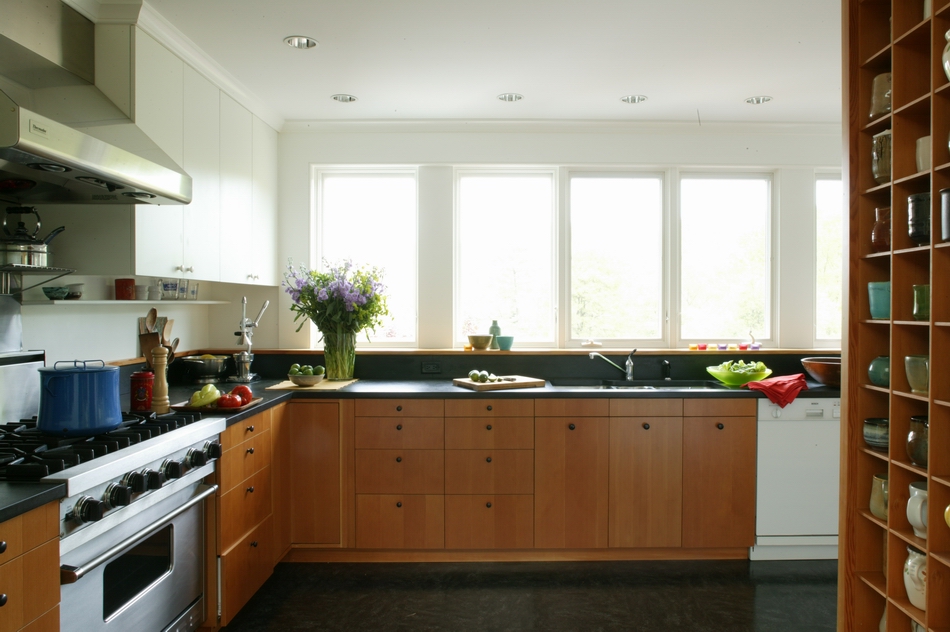
Image Credit: Karen Tanaka
Image Credit: David Peabody A mix of old and new. David worked his original appliances into the plan, including the commercial-style gas oven. The new counters—reminiscent of old lab tables—are made of Fireslate. The linoleum tiles are mostly made from plant-based materials—so are the wheatboard cabinet cases. Ginger chose white upper cabinets to reflect the already abundant light coming through the new windows.
Image Credit: Karen Tanaka Under the same roof. The brick wall and stone floor are carryovers from the carport that this breakfast room replaced. Building under the existing carport roof was the best way to get much-needed space without increasing the home's footprint. A new fully glazed back door brings in lots of light and connects the kitchen to the backyard.
Image Credit: Karen Tanaka Unobtrusive room dividers. A new doorway between the dining room and kitchen is integral to the more efficient layout. The pocket doors allow the family to separate the spaces when they want to. The fully glazed doors let lots of light in either way.
Image Credit: Karen Tanaka Better summer dining. Before building the new breakfast room (left side of photo), the carport it replaced doubled as a place to barbecue. The new, spacious deck is a more private and comfortable place to have a meal in the warmer weather.
Image Credit: Karen Tanaka Tough as nails. Ipé—also know as ironwood because of its durability—is an attractive, long-lasting deck material. Finding an FSC-certified supply of the wood is easier today than it was in 2002. Rounding out the list of tough materials are stainless-steel screws, galvanized pipe railings, and ACQ-treated lumber framing.
Image Credit: Karen Tanaka
A thoughtful redesign makes the heart of this home brighter, healthier, and more functional
After 10 years of working around the shortcomings of this 1950s kitchen, the owners felt it was time to change the room to meet their needs. Ginger, the cook of the family, was mostly concerned with function, but her architect husband, David, had additional plans for the space. Of course aesthetics were important to him, but David had a growing interest in and understanding of sustainable design and put these principles at the core of the project.
Working with existing space
One of David’s biggest concerns was how to get better work flow in the kitchen and a casual place to eat without building an addition. Fortunately, an adjacent carport (which had already served as a place for warm-weather dining) offered plenty of room to expand under its existing roof. A few walls were built and doors rearranged to create a fluid path from an adjacent dining room, through the kitchen, into the carport-cum-breakfast room, and out to the backyard. To replace the family’s barbecue space displaced by the breakfast nook, David built an FSC-certified ipé deck off the new back door.
More natural light
The old kitchen was cramped and dark—both characteristics that Ginger was anxious to change. Years of experience in this kitchen had helped her understand exactly how she worked when she cooked, which played a big role in deciding the new layout. David and Ginger felt that, with three kids in the house, an open space without an island made the most sense. To bring in plenty of natural daylight, they wrapped the back of the kitchen and two sides of the breakfast room with windows.
With the kitchen gutted and the walls opened up, the renovation offered a great opportunity to make the room more energy-efficient. Argon-filled, double-pane windows were the obvious choice. Because the new windows were not well sheltered from direct sunlight, David went with low-e, low-solar-gain glazing. Before closing everything up, he filled the old and new walls with cotton batt insulation and even added blown-in cellulose to the entire attic.
A challenging materials list
This renovation occurred in 2002, which wasn’t that long ago, but green products just weren’t as available as they are today. David spent hours on the phone just trying to track down the FSC-certified ipé. He wanted to use fluorescent lighting, but the cold hue and buzzing ballasts convinced him to switch to halogens.
Some choices weren’t as difficult. The custom cabinets are built with wheatboard—a formaldehyde-free particleboard made of wheat straw, an agricultural waste product. They also contain wood, but there’s about 60% less than in a conventional cabinet. The cotton and cellulose insulation contain 85% recycled, renewable materials. The linoleum floor tiles are mostly cellulose and linseed oil—very durable and easy to care for. Countertops are Fireslate— a cement-based material that has a lower embodied energy than the stone it replaces.
Weekly Newsletter
Get building science and energy efficiency advice, plus special offers, in your inbox.
Lessons Learned
This project came near the beginning of David's experience in green building. In retrospect, he would have focused more attention on the envelope and energy-efficiency details, even though this was essentially just an interior renovation. In fact, he's currently working out the details of a possible full-house superinsulation retrofit.
General Specs and Team
| Location: | Alexandria, VA |
|---|---|
| Additional Notes: | Existing kitchen space: 204 sq. ft. |
Architect: David Peabody, Peabody Architects
Builder: Grey Emmons, Emmons Contractors Inc.
Construction
Attic: fully insulated with blown-in cellulose (R-30, GreenFiber)
Walls (existing and new): 2x4 studs, cotton batt insulation (R-13, Bonded Logic)
Windows: double-pane, low-e, argon-filled glazing in wood frames (U-factor=0.29, SHGC=0.35, Marvin)
Energy
- Added insulation to existing wall and attic
- Double-pane, low-e windows
- Windows sized and located for better natural lighting
Indoor Air Quality
- Formaldehyde-free wheatboard cabinetry
- Linoleum flooring (naturally antistatic and antimicrobial)
Green Materials and Resource Efficiency
- Kitchen expansion built within existing carport
- Reused existing appliances
- Cellulose and cotton batt insulation
- Fireslate countertops
- FSC-certified ipé decking

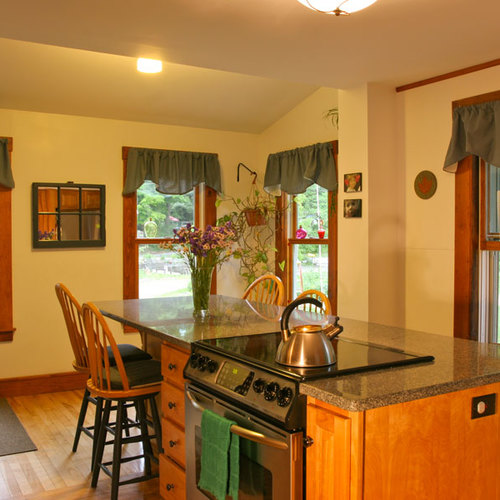
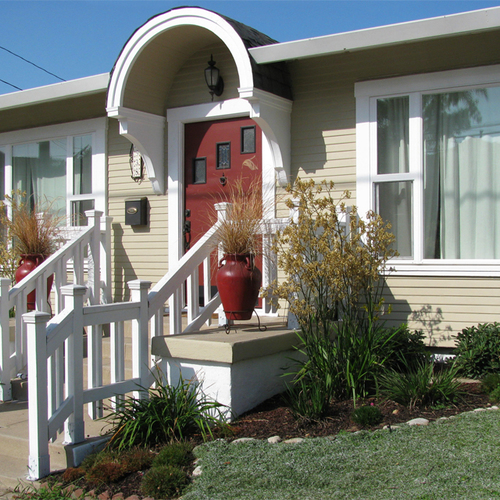
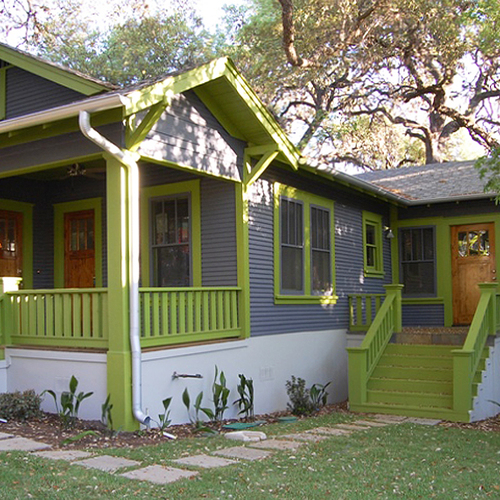
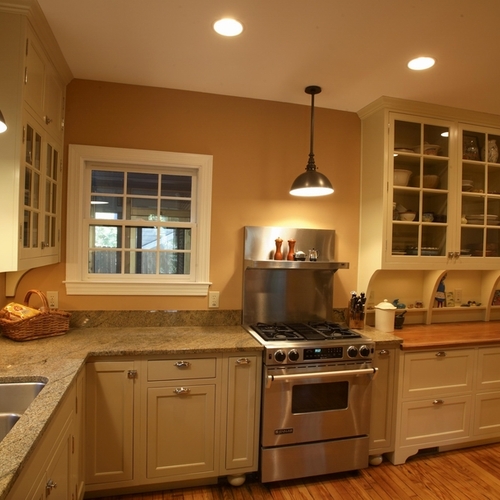






One Comment
WOW! to the Natural Light!!
Raised in Colombia we were used to lots of natural light at home, and to us surprise there's very few homes in the US that even open their drapes!!
So thumbs up for the Natural Light in this remodel!
Karen
Log in or create an account to post a comment.
Sign up Log in